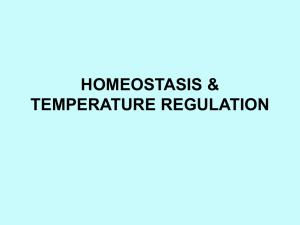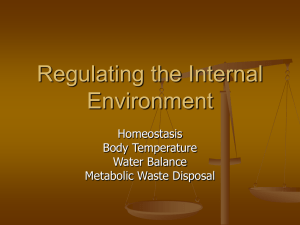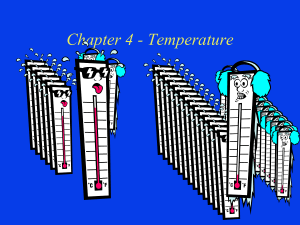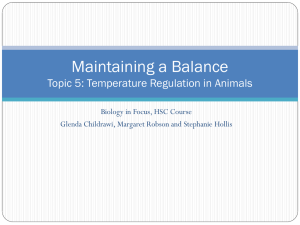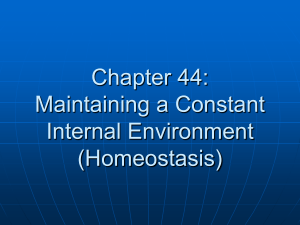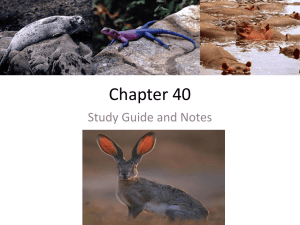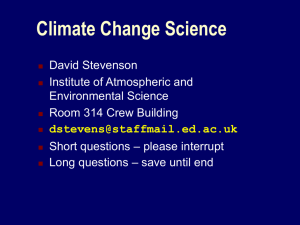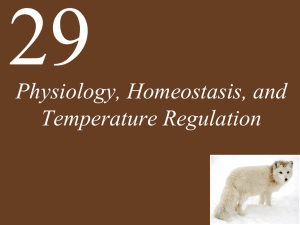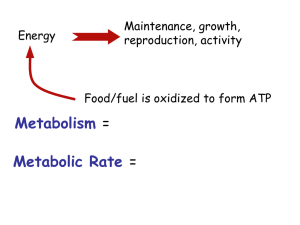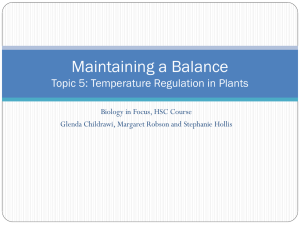ppt
advertisement
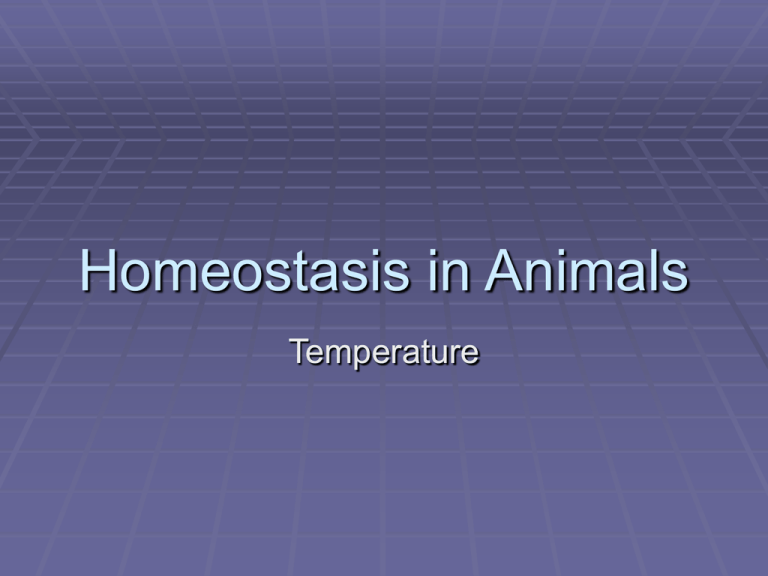
Homeostasis in Animals Temperature Processes of Heat Transfer Radiation = heat transfer through waves of energy Conduction = direct transfer of heat from one object to another Convection = heat transfer by circulation of a fluid (gas or liquid) Evaporation = heat loss as water changes from liquid to vapor Radiation Animals gain radiant heat directly from the sun and reflected from the atmosphere and objects in the environment Animals also lose heat as they radiate it to their environment Net gain during daytime, net loss at night Conduction Animals can either gain or lose heat to the ground or other objects depending on their relative temperatures lizard rock 30°C 20°C Animal loses heat when it’s warmer than contacted object 30°C 40°C Animal gains heat when it’s cooler than contacted object Convection Animals can gain or lose heat depending on relative temperature of animal and fluid Typically animals lose heat through convection because their body temperature is higher than air temperature Insulation of fur or feathers reduces convective heat loss brr! Evaporation Always results in heat loss from the animal Sweating, panting, and bathing are adaptations to increase evaporative heat loss to prevent overheating Bergmann’s Rule Individuals of a given species are larger in cold climates than in warm climates (generally speaking) White-tailed deer skulls Source: http://www.mun.ca/biology/scarr/ Bergmann's_rule_in_Odocoileus.htm Allen’s Rule Individuals of a given species have shorter extremities in cold climates than in warm climates (generally speaking) Arctic hare Snowshoe hare Black-tailed Antelope jackrabbit - boreal forest jackrabbit - Arctic - deserts - prairies tundra Source: http://www.mun.ca/biology/scarr/Lepus_variation.htm HOW SIZE MATTERS IN REGULATING BODY TEMPERATURE Concept Small-bodied animals or plant parts (e.g., leaves) heat up and cool down faster; bigger and/or thicker bodies heat up and cool down slower. Explanation Smaller/thinner bodies have a larger surface area to volume ratio. Bodies gain and lose heat out of the surface of their body; more surface area means greater gains and losses. Bodies retain heat within their bodies; more volume means more heat retention. When the surface area is large compared to the volume (small/thin things), heat is gained and lost quickly. Example: compare 1 cm x 1 cm x 1 cm cube with 10 cm x 10 cm x 10 cm cube 10 Large animal 10 1 Small animal 1 1 10 Surface area = 1x1x6 = 6 cm2 Volume = 1x1x1 = 1 cm3 SA:V ratio = 6:1 = 6.0 Surface area = 10x10x6 = 600 cm2 Volume = 10x10x10 = 1000 cm3 SA:V ratio = 600:1000 = 0.6 SIZE MATTERS Small cookies cool down faster than larger cookies after coming out of the oven. Also small cookies burn faster. Your hand has the same volume whether it is balled up (fat) or spread out (thin). On a cold day, your hand will get cold faster when spread out because balling up you hand into a fist effectively reduces surface area because now the part of your hand within your fist is no longer "surface". Advantages and Disadvantages to Being Large: Heat is gained and lost more slowly so, for example, on a hot summer day, the a large animal may never reach lethal temperatures by the time the sun sets. Because heat is lost more slowly, the animal doesn't have to replace lost heat as quickly Therefore, the animal doesn't have to eat as much compared to its body weight (e.g., only has to eat 1/4 its body weight). However, it usually does have to eat more total food than a smaller animal. Advantages and Disadvantages to Being Small: Heat is gained and lost faster so, for example, on a hot summer day, a small leaf (less than about 1 square centimeter) will shed heat as fast as it acquires heat Therefore the leaf will never reach temperatures higher than air temperature (compared to a large, thick leaf that acquires a heat load and can reach very high, lethal temperatures). Because heat is lost faster, the animal has to eat faster to replace the lost energy (e.g., very small mammals may eat up to 4 times their body weight each day). Summary Example A plant can either have very small leaves that never heat up higher than air temperature or very large leaves that heat up so slowly that they never reach lethal temperatures, but a plant doesn't want to have leaves in the middle sizes if the temperatures are going to be extremely hot or cold. Concepts Van't Hoff's Rule: for every temperature rise of 10 degrees C, rate of biochemical reactions (most body functions) doubles, up to a point (when proteins break down). What is the other name of this law? Energy Allocation: all energy taken in by plants and animals is portioned out (allocated) to the following areas Growth Reproduction Activity Maintenance Storage. Savings in one area (e.g., maintenance which includes thermoregulation) means more energy can be diverted to other areas (e.g., storage for hard times later). Types of Animals Based on Means of Thermoregulation: Ectotherms: animals whose principal source of body heat is the environment. Includes essentially all animals except birds and mammals. Endotherms: animals whose principal source of body heat is from their own body generating heat metabolically. Birds and mammals are endotherms. Types of Thermoregulation Behavioral Thermoregulation: using posture, orientation, and microclimate selection to regulate body temperature. For example, a lizard that wants to heat up will spread eagle (posture) on the top of a hot rock (microclimate) and turn its entire back to the sun (orientation). Physiological Thermoregulation: altering metabolic generation of heat to regulate body temperature. Poikilotherms (ectotherms) No internal physiological mechanism for keeping body temp constant Body temp matches environmental temp As temp drops body processes slow down Source of body heat is the environment Plants Reptiles Amphibians Most fish Most invertebrates Coping with Temperature Variation Poikilotherms Behavior When temp is low lizard sits broadside to sun and presses belly against warm rocks When temp is high lizard moves to shade, burrow, walks on tiptoe When temp is too low lizard seeks protected habitat and becomes inactive; outcome depends on how cold it gets Example Desert Iguana (Dipsosaurus dorsalis) in the southwestern US desert. In summer temperatures can exceed 45oC, and in winter temperatures are often below 0o During mid-July the thermal environment changes so rapidly that activity is limited to 45 minutes in the morning, and 45 minutes in the afternoon. Figure describes the diurnal and seasonal pattern of behavior: Coping with Temperature Variation Poikilotherms Physiology produce chemicals that lower the freezing point of cytoplasm freeze-tolerant species - have ice-nucleating agents (ECF freezes at lower temp than cytoplasm; prevents ice crystals) freeze-susceptible - produce glycerol etc; facilitate supercooling; lower freezing point to avoid ice crystals Advantages of being an Ectotherm Greater efficiency: allocate 30%-90% of ingested energy towards growth (<5% in most endotherms) Lower energy demands: can tolerate long periods with low food availability Less energetic cost for small body size: able to occupy more niches for smallbodied animals Large Ectotherms? As body size increases, surface area-to-volume ratio decreases, and large ectotherms are thus improbable. This had led to speculation that large dinosaurs may have had some degree of endothermy. Homeotherms (endotherms) Physiological mechanisms for controlling body temp Keeping warm Metabolic heat: increased metabolism, shivering Insulation (fat, fluffed fur or feathers) e.g. Birds, mammals Body size and shape Keeping cool Lower metabolic heat production Evaporation: panting, sweat Body size and shape Birds Mammals Range and limits of homeothermy Thermoneutral zone = range of environmental temperatures over which an animal can maintain a constant body temperature without raising its metabolic rate Lower and upper critical temperatures = environmental temperatures at which animal must raise its metabolic rate to maintain homeothermy Lower and upper lethal temperatures = environmental temperatures at which animal can no longer raise its metabolic rate and dies Coping with Temperature Variation Homoiotherms Behavior Burrows, dens, shade during hottest part of day Sled dog, arctic fox wrap tail around face Grouse burrows under snow Gular fluttering Urohydrosis Urohydrosis Excretion on the feet or legs which evaporates and then cools the organism as the excretion evaporates This is a common adaptation in birds such as turkey vultures. A similar adaptation is seen in Kangaroos which lick their forearms to wet them with saliva. Cactus Wren: Daily behavior reflects the temperature of the microhabitats used. The orientation of the nest changes during the breeding season in order to maximize cooling in this desert environment. Coping with Temperature Variation Homoiotherms Morphology Coloration is thought to be an important factor in the reduction of heat absorption. A lighter colored coat will reflect more light relative to a darker coat which will absorb more light. The result is reduced body temperatures and more water conservation. Insulation in the form of feathers, hair, or even body fat which protects tissues beneath by insulation. Enlarged appendages (desert Jackrabbit’s ears) in order to increase surface area and hence promote heat loss. Desert Jackrabbit Arabian oryx Coping with Temperature Variation Homoiotherms Physiology – keeping warm requires lots of food Increased body fat for cold weather insulation Increased metabolic rate Shivering (heat from muscle activity) Increase air spaces by fluffing feathers, fur Counter current mechanisms During the winter, the Willow Ptarmigan produces a denser coat of feathers and actually down-regulates its basal metabolism, which reduces the gradient between the internal body temperature and the external temperature. This is the same as keeping your house at a cooler temperature in order to reduce your heating bill. Both responses reduce the amount of energy necessary to stay warm. Metabolic Heat Production Endotherms produce heat by oxidizing energyrich carbohydrate molecules C6H12O6 + 6 O2 → 6 CO2 + 6 H2O + energy Some of the energy is stored but much is dissipated as heat Metabolic rate = rate at which energy-releasing chemical reactions occur Basal (standard) metabolic rate = lowest rate of energy expenditure of resting, fasting animal in its comfortable temperature range Counter current heat exchange Mammalian Counter Current Example Reduce Heat Input Staying out of the sun Shading (e.g., spines/fur) Posture and orientation (e.g., orienting leaves vertically to minimize surface area directly hit by sun) Insulation Shiny surfaces that reflect sun, etc. Dissipating Heat If heat reduction wasn't enough, then it is time to get rid of body heat by evaporation (costs water though), long appendages (legs, ears, etc.), or small "bodies" (e.g., whole body, leaves, etc.) that radiate heat. Tolerate Hyperthermia Some plants and animals can survive body temperatures that would be dangerous to humans (e.g., this antelope ground squirrel tolerates body temperatures over 104 degrees F!). Advantages of being an endotherm Tolerate a wider range of environmental conditions Can be active day or night, year round Can sustain high levels of activity for longer periods because rely more on aerobic metabolism (anaerabic in ectotherms) Disadvantages of Homeothermy Homoiotherms can’t shut down completely if food, water, or oxygen disappear Homeotherms can’t be as small as poikilotherms. Lose too much heat as SA/V increases and can’t eat enough to keep warm. Homeotherms can't be wormlike or snakelike in shape. High SA/V - lose too much heat. Aquatic env favors poikilotherms because of high rate of convection. Other Adaptations Partial homeothermy - Swordfish, Tuna, GW Sharks Hunts near surface during the day; goes deep at night T may be as much as 19oc Has brain-eye heater to keep these organs at stable temp (needed for hunting) Tissue rich in mitochondria; countercurrent blood supply; thick layer of fat around brain and eyes Heterotherms - warm-blooded species that hibernate (temporary poikilothermy) Temporary homeothermy during egg incubation by some snakes Heat stable enzymes in thermophilic bacteria Endothermy in insects: sphinx moths active moths maintain constant metabolic rate regulate body temp by modifying cooling rate heat produced by flight muscles in thorax is transported via circulatory system to abdomen Ecology of Bumblebees Bumblebees live in many cool regions. Bernd Heinrich estimated the energy budget of individuals foraging on different flowers and under different temperatures. Energy Gain / Loss Energy Intake - Energy Expenditure. How to Keep Warm More Examples Bask Compact Body Shiver Hibernate Hibernate The Grizzled Checkerspot butterfly also is very short lived as an adult. As a caterpillar, it takes two summers of eating before it is ready to pupate and metamorphose into an adult butterfly, so it has to hibernate twice. Since most of this species is on the same two-year cycle, you are only likely to see these butterflies in odd years! Burrow Below Ground "Gopher Eskers" Burrow Below Ground Pocket Gopher Stay Awake and Hoard Food Migrate
